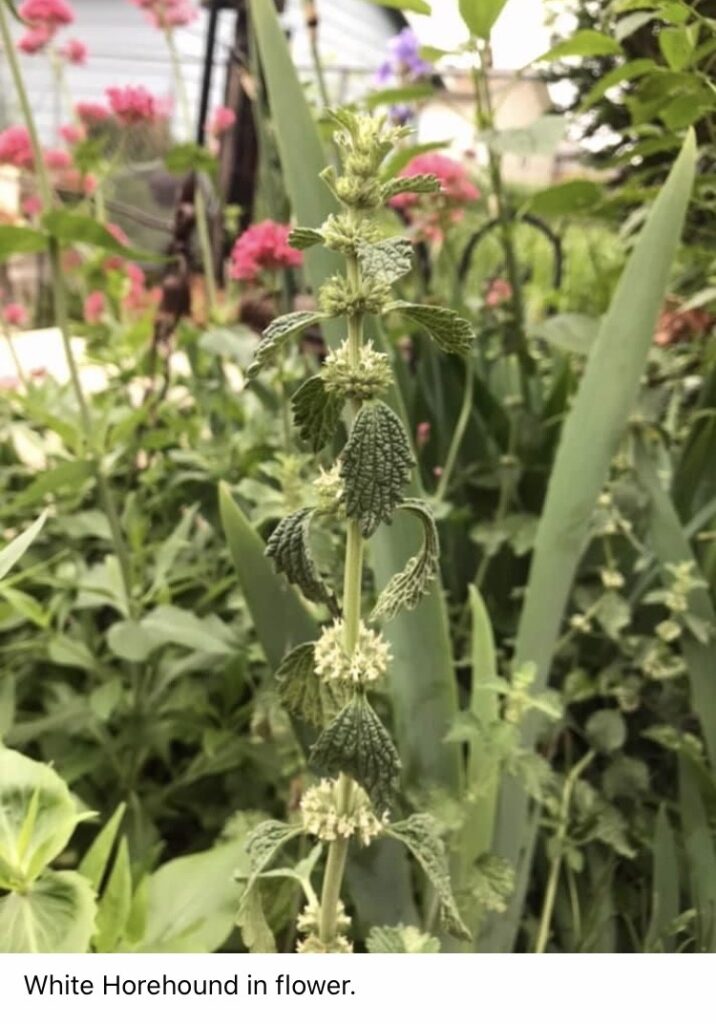This is the second in a series titled My Friend Herb. The intention is to introduce you to some of my favorite herbs, their traditional uses and the stories surrounding them that have been passed down through the ages.
Today I would like to introduce you to my friend Herb. He is formally known as Marrubium vulgare, but his friends call him White Horehound. He is originally from the Mediterranean with unmistakable whorls of woolly grey hair. He prefers to be dry, often dying from being too wet. Unlike most herbs he should be harvested when he is in bloom.
I was introduced to Horehound by a mutual friend, Kay Young. For Christmas Kay would give me her homemade horehound lozenges. We became fast friends as Horehound is a master phlegm busting cough eliminator and fabulous at snipping a cold in the bud.
In the first century AD, Horehound was a trusted friend of Greek physician, Pedanius Dioscorides. His De materia medica was an encyclopedia of herbal medicine reportedly used by the Roman army as they expanded the Roman Empire. As the Roman army traveled so did the healing reputation of Horehound from the Mediterranean to other parts of the world. Seen as essential to survival, Horehound later accompanied those who invaded South and North America bringing Horehound to yet another continent.
One of my most cherished herb books is Hildegard von Bingen’s Physica written in the 1150s. Horehound was also one of Hildegard’s allies. Used to combat sore throats, coughs, weak and feeble intestines, hearing loss, headaches, red leprosy, malaria, and as a poison antidote.
Five hundred years later Horehound was a trusted companion of a rebelious physician, Nicholas Culperer. He published Culperer’s British Herbal in 1653 with the radical notion to share natural medicine with the masses. He used horehound to bring down courses and expel the afterbirth, break up tough phlegmy coughs, asthma, antidote for poison, treat wounds and dog bites, yellow jaundice, ear pain, kill parasitic worms, as well as to opens obstructions of liver and spleen.
Some herb books refer to horehound as one of the bitter herbs used during the Passover Seder meal. Even suggesting that Horehound’s botanical name comes from the Hebrew word ‘maror’ meaning bitter herb or juice. The sticking point is that I have yet to find a practicing Jew who has used horehound in the Passover Seder meal. (Note~If you do please let me know!!) This isn’t surprising since horehound is not really a culinary herb you would pop into your mouth or throw into a salad. Even medicinal use of horehound in tea, lozenges or oxymels are more palatable with a good bit of sweetener.
Well that is a little about my friend Horehound. I hope now that you have been introduced you will get to know each other better!
Standard herbal disclosure ~ this is for informational purposes and not meant as medical advice.
Note~When a plant has vulgare or officinalis as part of their botanical name It is a signal that you have medicinal herb. Vulgare is latin for Common. In the days when people where expected to have basic healing herbs in their garden, vulgare denoted a plant which was assumed you would have in your herb garden. Officinalis is a plant that was traditionally sold in apothecaries, so considered to be medicinal or healthful.
My Friend Herb~Catnip, by Jill Kuhel
My Friend Herb~Horehound, by Jill Kuhel
I’d Like to Introduce You to My Friend Herb ~ French Tarragon, by Jill Kuhel





